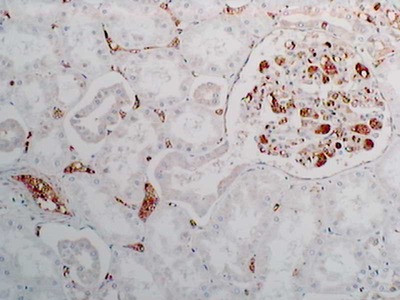- HOME >
- For Researchers >
- Product Search >
- Search Result >
- #18903 Anti-Human GLUT-3 Rabbit IgG Affinity Purify
Product Search
#18903 Anti-Human GLUT-3 Rabbit IgG Affinity Purify
- Intended Use:
- Research reagents
- Application:
- WB, IHC
- Package Size1:
- 100 μg
- Package Size2:
- 10 μg
- Note on Application Abbreviations
- WB:Western Blotting
- IHC:Immunohistochemistry
※ The product indicated as "Research reagents" in the column Intended Use cannot be used
for diagnostic nor any medical purpose.
※ The datasheet listed on this page is sample only. Please refer to the datasheet
enclosed in the product purchased before use.
Product Overview
Product Overview
| Product Code | 18903 |
|---|---|
| Product Name | Anti-Human GLUT-3 Rabbit IgG Affinity Purify |
| Intended Use | Research reagents |
| Application | WB, IHC |
| Species | Human |
| Immunizing antigen | Synthetic peptide of the C terminal part of human GLUT-3 (SGKDGVMEMNSIEPAKETT) |
| Purification Method | Purified with antigen peptide |
| Specificity | Confirmed by western blotting using transfectant cells. |
| Package Form | Lyophilized product from PBS containing 1 % BSA and 0.05% NaN3 |
| Storage Condition | 2 - 8℃ |
| Poisonous and Deleterious Substances | Applicable |
| Cartagena | Not Applicable |
| Package Size 1 | 100 μg |
| Package Size 2 | 10 μg |
| Remarks1 | The commercial use of products without our permission is prohibited. Please make sure to contact us and obtain permission. |
Product Description
Product Description
Mammalian cells transport glucose through a family of membrane proteins known as glucose transporters (GLUTs or SLC2A family). Mammalian tissues are known to express different glucose transporter isoforms (exisiting at least GLUTs 1-13) in different tissues. The molecular weight are 40-60 kDa, respectively. GLUT-1 has a high affinity with glucose (Km 1-5 mM) and mediates glucose transport into red cells, and throughout the blood brain barrier. It is ubiquitously expressed and transport glucose in most cells, such as red cells, embryo tissues, brain, kidney or tumor cells. GLUT-3 has a high affinity with glucose (Km 1 -5 mM) and is the main transporter in brain (neurons). GLUT-5 transports fructose in intestine and testis. Especially, our GLUT-5 antibody detects microglia selectively in immnostaining, and doesn't react with monocytes and monocyte-derived macrophages. Immunostaining by this antibody excels in the form observation compared with staining by other antibodies reported as microglia markers, and it makes it easy to distinguish between a static type and an active type in the form observation.























